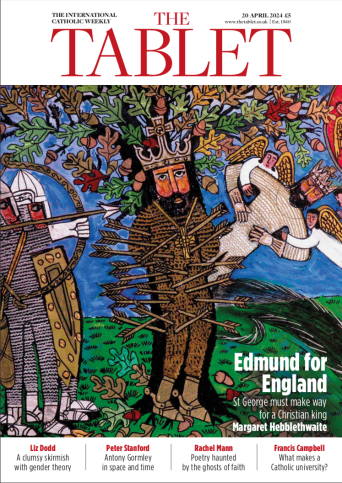Beauty, as Fyodor Dostoevsky wrote in The Brothers Karamazov, is “mysterious as well as terrible. God and the Devil are fighting there and the battlefield is the heart of man.” Nobody represents that theology better than Pope Emeritus Benedict XVI, though it was the uplifting appeal of beauty rather than its darker side that interested him most. Nevertheless as a “Mozart man”, as he once called himself, he understood the power of beauty to shock and disturb, as for instance in the “Dies Irae” of Mozart’s Requiem.
The truth is that in the appreciation and wonder of great art, barriers between people of faith and those without quickly blur. Thus the cover of this week’s Christmas edition of The Tablet is illustrated by the work of Charles Mahoney, who produced the stunning murals in the Lady Chapel of Campion Hall, Oxford, during and after the Second World War. He confessed to atheism, but the then master of Campion, Martin D’Arcy SJ, sensed in his work an understanding of the transcendent. D’Arcy believed, as does Benedict, that the via pulchritudinis is a pathway to experience of the divine even if not known by that name.
If Dostoevsky is at all right, and the battlefield in “the heart of man” of which he speaks is a fitting place to explore spiritual and moral truth, then it is not necessary to carry an entrance ticket marked with signs of faith. That exploration can lead to shared insights at a profound level between believers and non-believers, which is why The Tablet is committed to maintaining its presence in the seemingly secular world of the arts, performing and visual. In Benedict’s sense, it is not a godless world at all.
Beauty points us to God even if only implicitly. Nor is it necessary for the work of beauty to have an overtly religious purpose. Aquinas saw that in whatever field of art, beauty required integrity, proportion and clarity (or luminosity). The art critic or reviewer, in discerning the presence or otherwise of these qualities, is truly engaged in a theological task although it is never called that. It is enough to invoke the famous opening words of the Vatican II decree Gaudium et Spes: “The joy and hope, the grief and anguish of the men of our time ... are the joy and hope, the grief and anguish of the followers of Christ as well. Nothing that is genuinely human fails to find an echo in their hearts.” So the task of the critic or reviewer is to visit that battlefield of Dostoevsky, and report on the state of things, mysterious as well as terrible, to be found there – many griefs, many anxieties, but much consoling inspiration and a glimpse of the divine presence as well.
17 December 2015, The Tablet
Beauty points the way to God
Edmund for England
 Loading ...
Loading ...
Get Instant Access
Subscribe to The Tablet for just £7.99
Subscribe today to take advantage of our introductory offers and enjoy 30 days' access for just £7.99



What do you think?
You can post as a subscriber user...
User Comments (0)